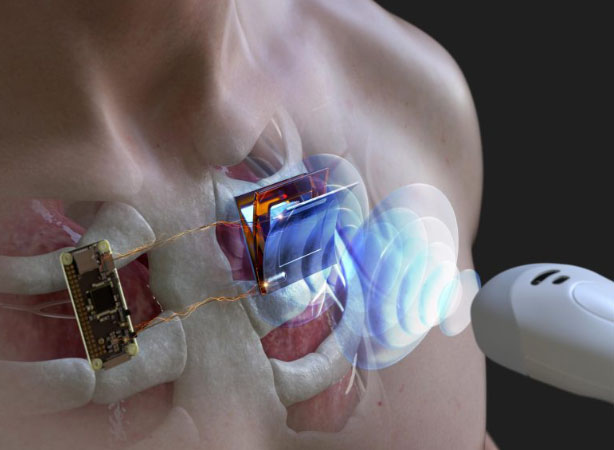New research helps to charge pacemaker batteries without surgery
A research team from the Korea Institute of Science and Technology (KIST) has found a way to charge the batteries for pacemakers and implanted devices under the human body with sound waves, helping patients avoid surgery like before.
Pacemakers are currently considered an effective device in supporting patients with arrhythmias when helping patients maintain a stable heart rhythm.

Illustration of charging with sound waves for a pacemaker
However, the device also has limitations when the battery life is limited and needs to be replaced through surgery. This battery replacement surgery can lead to health complications for the patient.
The Korean Institute of Science and Technology (KIST) has researched to solve the above problem. In it, the battery is charged via wireless power generated from ultrasonic waves without surgery.
Specifically, the team developed a model based on the application of the triboelectric effect, which allows an object to become charged after there is friction with another object. They took advantage of the vibration of the sound wave's frequency to create friction with a material called tribo, a charged material, to generate electricity.
The research has generated a power source enough to make 200 LEDs glow with an output of 8 Mili Watt at a distance of 6cm. Research also shows high energy conversion efficiency and small amount of heat generation.
This power is enough to help fully charge the batteries of pacemakers as well as some other devices implanted under the human body, according to the scientific journal Scitechdaily.
Dr Song, a member of the research team, said: "If the stability and efficiency of the device is further improved, in the future this technology can be applied to power devices. implanted in the human body without surgery".
- Heart surgery at age 106
- Biological heart rhythm by gene therapy
- Batteries made from seawater charge 80% in 5 minutes, better performance, safer
- Prospects for development
- Nanotechnology helps the battery pack charge fast but lasts a long time
- Small heart pacemakers and wireless charging
- Charge the power with the chassis
- We are all charging the phone the wrong way
- Successfully implanted wireless pacemaker
- Microsoft has solved the most annoying battery problem, but why have we never heard of it?
- Found a replacement for the battery in your phone
- Battery runs for 30 years without charging
 13 causes of non-itchy rash
13 causes of non-itchy rash How the mouse with human ears changed the world?
How the mouse with human ears changed the world? The truth about 'fried rice syndrome!
The truth about 'fried rice syndrome! What is dental implant?
What is dental implant?